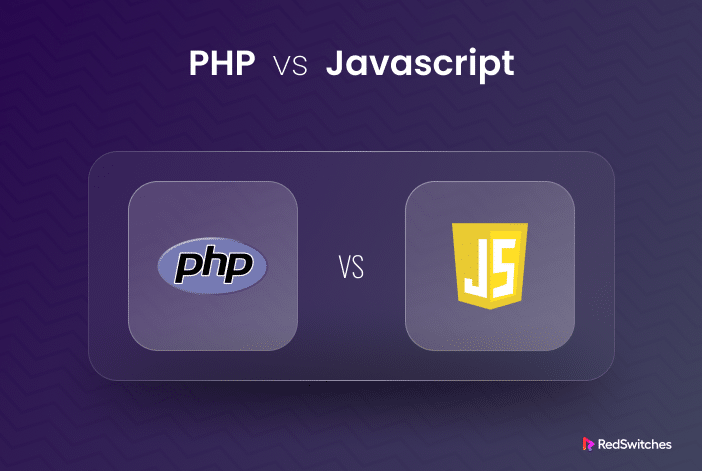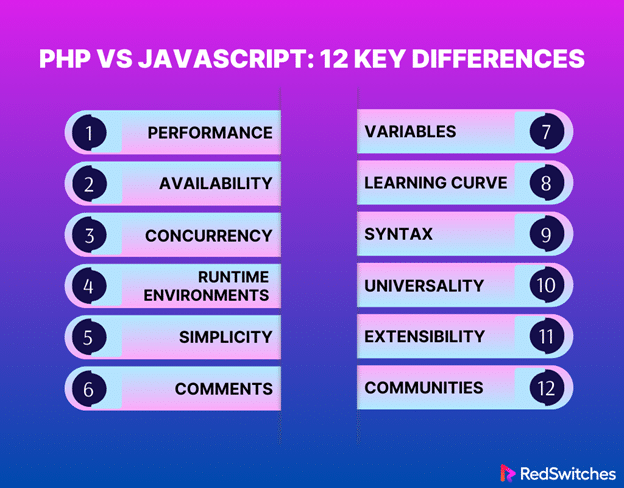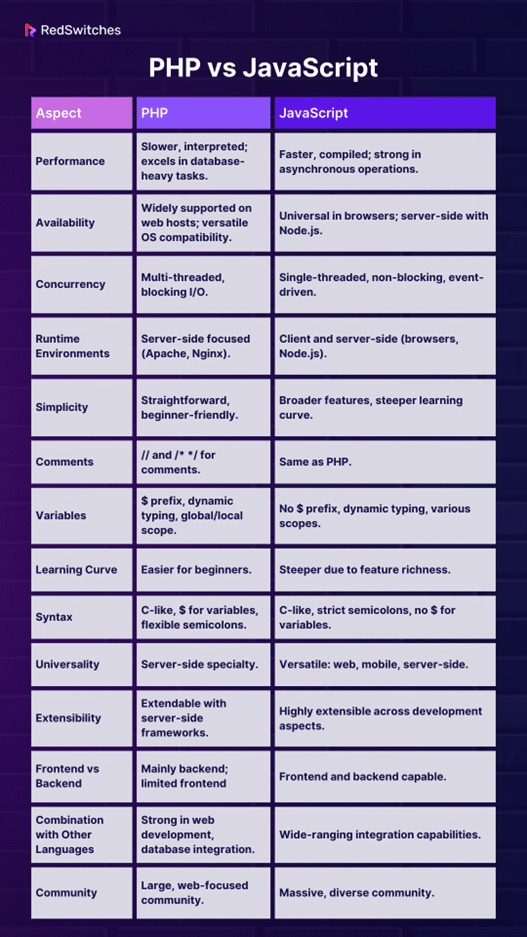In the vast web development realm, few web languages, as prominently as PHP vs JavaScript, have dominated the scene. Both have shaped the contours of the internet, powering millions of websites, applications, and dynamic user experiences.
Yet, despite their shared territory in the digital domain, each language possesses unique strengths, applications, and philosophies. This article explores PHP and JavaScript in depth, delving into their histories, intricacies, and distinctive roles in the ever-evolving web.
Whether you’re a seasoned developer, a business stakeholder, or a tech enthusiast, join us as we dissect and contrast these two behemoths of the coding world, unraveling the nuanced differences and shared attributes that have solidified their positions as keystones in web technology.
Table of Contents
- What is PHP?
- What is JavaScript?
- Key Differences Between PHP vs JavaScript
- Frontend vs Backend
- Communities
- PHP vs JavaScript: Use Cases and Real-Life Examples
- Conclusion
- FAQs
What is PHP?
PHP, an acronym for “PHP: Hypertext Preprocessor,” has been a leading player in web development. This open-source server-side scripting language, tailored expressly for web development, boasts a broad reach: it is harnessed by a staggering 76.8% of all websites whose server-side programming language is known.
Credit: Freepik
PHP’s inception can be traced back to 1995, when Rasmus Lerdorf introduced it to the digital world. Its trajectory since then has been nothing short of impressive. From its humble beginnings, PHP has undergone significant refinements and expansions, and today, it is the force behind prominent platforms such as WordPress, Joomla, and Drupal.
Here’s a breakdown of some of PHP’s standout features and capabilities:
- Server-side Scripting: PHP runs on the server side, meaning it processes the data and logic on the server and then sends the resulting output (usually HTML) to the client’s browser.
- Embedded in HTML: PHP can be embedded directly within HTML code, allowing for dynamic content generation based on various conditions and inputs.
- Database Interaction: PHP seamlessly integrates with databases, making it a go-to for web applications that require data storage and retrieval, such as e-commerce sites or content management systems.
- Cross-platform: PHP runs on various platforms, including Windows, Linux, and macOS, offering developers flexibility in choosing their server operating system.
- Extensive Libraries: Over the years, the PHP community has built an extensive collection of libraries and frameworks, like Laravel and Symfony, that speed up the development process and enhance functionality.
PHP Syntax
Understanding PHP’s syntax is crucial for anyone diving into web development with this language. The syntax lays the foundation for writing effective, error-free PHP scripts. Here are some key points:
- PHP scripts start with <?php and end with ?>.
- PHP variables begin with the $ sign, followed by the variable name.
- Statements end with a semicolon (;).
Example
To give you a basic idea of what PHP looks like in practice, consider the following simple example that displays a greeting message:
<?php
$greeting = “Hello, World!”;
echo $greeting;
?>
In this example:
- We start and end the script with the PHP tags.
- We declare a variable $greeting and assign the string “Hello, World!” to it.
- The echo statement displays the value of the $greeting variable, sending “Hello, World!” to the browser.
To sum up, PHP is an incredibly versatile language that has stood the test of time in web development. Its intuitive syntax, coupled with its powerful server-side capabilities, makes it a favorite among both beginners and seasoned developers. Whether you’re looking to create a simple website or a complex web application, PHP provides a robust foundation to build upon.
What is JavaScript?
JavaScript, often simply called JS, is one of the three pillars of web development alongside HTML and CSS. As a lightweight, interpreted, object-oriented language with first-class functions, JavaScript’s primary role is to bring interactivity to web pages, enhancing the user experience and transforming static pages into dynamic ones.
A testament to its dominance in the field, JavaScript is utilized as a client-side programming language by 98.8% of all websites.
Initially introduced in 1995 by Netscape to add interactive elements to websites, JavaScript has witnessed a meteoric rise. Its capabilities have grown immensely and are no longer limited to just the browser. With the advent of platforms like Node.js, JavaScript can now also be used server-side.
Highlighting some of JavaScript’s salient features:
- Client-side Execution: Traditional JavaScript runs in the user’s browser without constant communication with the server. This leads to more responsive web applications.
- Versatility: Its primary use is in web browsers; JavaScript can run on servers, databases, and even robotic equipment, thanks to platforms like Node.js.
- Event-driven: JavaScript waits for events (like user interactions) and reacts to them, making it perfect for creating interactive web applications.
- Support for Libraries and Frameworks: Numerous libraries (like jQuery) and frameworks (like React and Angular) are based on JavaScript, which aids developers in creating feature-rich applications more efficiently.
Curious about setting up Node.js on Ubuntu 22.04? Discover Three Simple Ways You Can Install Node.js On Ubuntu 22.04 as you dive deeper into PHP vs JavaScript. Don’t miss out!
JavaScript Syntax
Understanding the syntax is paramount for anyone aiming to master JavaScript. Here’s a brief overview:
- Statements in JavaScript are commands to the browser and are separated by a semicolon (;).
- Variables can be declared using let, const, or var (though using var has become less common in modern JavaScript).
- Functions are used to store blocks of code that can be reused.
Credit: Freepik
Example
To offer a glimpse of JavaScript in action, consider this elementary example that pops up a greeting message to the user:
let greeting = “Hello, World!”;
alert(greeting);
In the above code:
- A variable named greeting is declared using let and is assigned the string “Hello, World!”.
- The alert function then displays a popup with the message stored in the greeting variable.
In summation, JavaScript is the heartbeat of interactive web applications. Its ubiquity and evolving capabilities ensure it remains an indispensable tool in any web developer’s toolkit. JavaScript is up to the task, whether animating a dropdown menu, fetching data without reloading the page, or building a full-fledged single-page application.
Transitioning between Windows and Linux for your development needs? Enhance your PHP vs JavaScript journey by mastering the Node.js and npm setup process. Check out our definitive guide: Node.js and npm Installation Made Easy: Windows and Linux Edition.
Key Differences Between PHP vs JavaScript
Navigating the expansive web development landscape often leads to comparisons between dominant languages. One such comparison, which frequently becomes the topic of discussion among developers and tech enthusiasts, revolves around PHP vs JavaScript: Key Differences. Both languages have carved out their respective niches, offering unique strengths and capabilities. This section will delve deep into these two juggernauts, unraveling the pivotal differences that set them apart and enabling you to make informed decisions for your projects.
Performance
In the digital world, the performance of a language can significantly influence the user experience. When deliberating between PHP vs JavaScript, understanding their performance capabilities can guide decision-making processes, especially for developers and businesses.
Speed and Execution
- Nature of the Language:
- JavaScript: Generally faster than PHP since it is a compiled language, meaning the JavaScript code is transformed into machine code before its execution, facilitating faster operations.
- PHP: An interpreted language, PHP code gets executed line by line, a process that tends to be slower in comparison.
- Concurrency:
- JavaScript: Benefits from an asynchronous programming model, allowing it to execute several tasks concurrently. It doesn’t need to complete one task to initiate another, leading to smoother, more efficient performance in specific scenarios.
- PHP: Employs a synchronous model, executing tasks one after the other,
potentially leading to waiting times between tasks.
Wondering how server speed impacts the PHP vs JavaScript debate? Boost your website’s performance with our 16 Tips on How to Increase Your Server Speed & Performance. Supercharge your server and experience lightning-fast results!
Database Interactions
While JavaScript excels in many performance areas, PHP often outshines when heavy database interaction is required.
- PHP: Typically faster in tasks requiring extensive database interactions, owing to its built-in database support.
- JavaScript: Traditionally slower in direct database interactions since it lacks innate database support but can be coupled with backend solutions to handle such tasks.
Application Suitability:
Depending on the nature and requirements of your project, one might be more suited than the other:
- PHP: Ideal for websites, blogs, e-commerce platforms, content management systems (CMSs), and web APIs.
- JavaScript: The go-to for web applications, mobile apps, real-time applications, games, and single-page applications (SPAs).
Ongoing Evolution
It’s pivotal to recognize that the landscape of PHP vs JavaScript performance isn’t static:
- Both languages continually advance, with performance enhancements and new features regularly introduced.
- Developers can further augment the performance of both PHP and JavaScript through caching, employing optimization techniques, and selecting the right hosting environment.
In conclusion, while JavaScript typically offers faster performance due to its compiled nature and asynchronous model, PHP holds its ground, especially in database-heavy tasks. The choice between PHP and JavaScript should be driven by the project’s specific needs, bearing in mind that both languages, with the right strategies, can be optimized for peak performance.
Availability
The digital ecosystem of PHP vs JavaScript for web development has constantly been at the forefront of discussions in the developer community. As they weigh their options, availability becomes a significant determinant. Both PHP and JavaScript are ubiquitous in their respective spheres, yet they exhibit distinct features that offer varying advantages.
Platforms and Devices
- Web Hosting:
- PHP: Almost universally supported by major web hosting providers, PHP ensures wide compatibility for websites and web applications. Whether using shared hosting, VPS, or dedicated servers, you will likely find PHP pre-installed.
- JavaScript: It’s the backbone of modern web interactivity. Given that it’s built into all major web browsers, any device with a browser, be it desktop or mobile, is equipped to handle JavaScript code natively.
- Operating Systems:
- PHP: PHP’s open-source nature has led to its availability across a spectrum of operating systems. PHP can be easily installed and operated, whether it’s Windows, MacOS, Linux, or Unix.
- JavaScript: Its universal presence isn’t just restricted to browsers on desktops. Mobile devices, tablets, and even some smart devices come equipped with browsers capable of interpreting and running JavaScript.
Frameworks and Libraries
Frameworks and libraries amplify the capabilities of languages, providing pre-built solutions and structures:
- PHP: Developers have access to a rich set of frameworks like Laravel (for MVC architecture), Symfony (for complex web applications), and CodeIgniter (for rapid development). Libraries further enhance functionalities, aiding in tasks from database abstraction to authentication.
- JavaScript: The ecosystem is vast. Frameworks like React (for UI building), Angular (for SPAs), and Vue.js (for progressive web apps) have grown in popularity. Numerous libraries, like jQuery, underscore.js, and D3.js, extend its capabilities further.
Community Support
The strength of a programming language often lies in its community:
- PHP: With a history spanning over two decades, PHP has nurtured a large, engaged community. This translates to numerous tutorials, forums, workshops, and conferences dedicated to PHP development.
- JavaScript: Given its universal application, JavaScript’s community is colossal. This ensures regular updates, a plethora of learning resources, and solutions to almost any problem a developer might encounter.
Understanding availability nuances is crucial in the debate of PHP vs JavaScript for web development. While JavaScript offers unparalleled universality, especially with the rise of Node.js allowing server-side operations, PHP remains a stalwart for specific server-side tasks, particularly those requiring deep database integrations.
Ultimately, the best outcomes often emerge when developers harness both strengths, using PHP and JavaScript collaboratively to create dynamic, efficient, and user-friendly web solutions.
Concurrency
In the intricate web of PHP vs JavaScript, a pivotal aspect that invariably arises is their handling of concurrent operations. Concurrency is crucial as it determines how efficiently a language can manage multiple simultaneous tasks, a key component in today’s real-time, multi-user digital applications.
Credit: Freepik
Approach to Concurrency
- PHP:
- Multithreading: PHP, being multi-threaded, can execute multiple tasks simultaneously. However, it’s essential to note its utilization of a blocking I/O model. When a task awaits I/O operations, it hampers the entire thread, potentially leading to performance snags, especially for applications inundated with concurrent requests.
- Event-driven Model & Non-blocking I/O: Unlike JavaScript, PHP doesn’t natively support these, which could be a limiting factor in specific scenarios.
- JavaScript:
- Single-threaded Nature: Despite being single-threaded, JavaScript’s prowess lies in its event-driven, non-blocking I/O model. This architecture ensures that multiple concurrent tasks can be managed without stalling the primary thread.
- Real-time Applications: Given its non-blocking nature, JavaScript is a superior choice for real-time applications or projects demanding extensive concurrent handling.
As the PHP vs JavaScript battle continues, your hosting choices can make all the difference! Learn how to make the best decision with our guide: Choosing the Right Web Hosting for Developers.
Selecting Based on Concurrency
Your application’s specific requirements will influence your choice:
- JavaScript stands out for real-time applications or projects that need to manage a flurry of concurrent requests due to its event-driven, non-blocking nature.
- On the other hand, if your project is primarily database-centric, PHP might be preferable due to its robust database interaction capabilities.
Practical Application
- PHP: It is adept at concurrent database interactions, enabling a web application to execute several database queries simultaneously, essential for high-traffic websites and complex data-driven applications.
- JavaScript: In real-time chat applications, JavaScript manages multiple user connections effortlessly. In Single Page Applications (SPAs), it can update the UI seamlessly without page reloads, even as other tasks operate in the background.
In conclusion, while JavaScript often takes the crown in concurrency-centric applications, it’s essential not to sideline PHP, especially for database-driven endeavors. Embracing both strengths can yield dynamic, efficient, and concurrent web applications.
Runtime Environments
Delving into the PHP vs JavaScript debate, one cannot overlook the pivotal role of runtime environments. They dictate where and how our code runs, thus directly impacting the efficiency, accessibility, and scalability of our applications.
Fundamental Nature
- PHP:
- Server-side Scripting: PHP primarily operates as a server-side language. When a user requests a PHP page, the server processes the PHP code and only then sends the resultant output to the client’s browser.
- Popular Environments: The most prevalent PHP runtime environment is Apache. However, Nginx and LiteSpeed are also prominent choices, each bringing their unique advantages to the table.
- JavaScript:
- Client-side Scripting: Traditionally, JavaScript has been a client-side language, executing directly within the user’s browser, enhancing user experience and interactivity.
- Expanding Horizons with Node.js: With the advent of Node.js, JavaScript transcended its client-side confinement, enabling server-side application development.
Selecting the Ideal Runtime
Your project’s nature and requirements will influence your runtime choice:
- Web Applications: The chosen language’s corresponding runtime environment is paramount for those venturing into web application development. PHP developers typically gravitate towards Apache or Nginx, while JavaScript aficionados would consider the V8 engine or, for server-side endeavors, Node.js.
- Diverse Choices: The tech landscape offers a plethora of runtime environments tailored to specific needs. High-performance PHP applications might leverage specialized PHP runtimes. Similarly, for mobile-centric projects, JavaScript runtimes are honed for mobile development.
Factors to Ponder
- Performance: High-stakes projects demand runtime environments reputed for their swiftness and efficiency.
- Features: Environments differ in offerings — from caching and load balancing to security measures.
- Community Support: A community’s strength and activity level can be a game-changer, especially when troubleshooting or seeking optimization advice.
While the debate between PHP and JavaScript endures, the decision on runtime environments hinges on the application’s unique demands, ensuring a smooth, efficient, and tailored development experience.
Simplicity
Within web development, opting for a particular programming language often pivots on its simplicity and ease of adoption. Navigating the PHP vs JavaScript conversation, we unearth distinct attributes of both languages, influencing their learning curves and application ranges.
Ease of Learning
- PHP:
- User-Friendly Syntax: PHP is often lauded for its uncomplicated syntax, which tends to be more linear and intuitive, making it a favorite among newcomers.
- Fewer Features, Less Complexity: With its narrowed focus, PHP doesn’t overwhelm beginners with many features.
- Supportive Community: The PHP community is extensive and proactive, offering invaluable resources, tutorials, and support to learners.
- JavaScript:
- Intricate Nuances: JavaScript, encompassing a broader spectrum of features, can present a steeper learning curve, particularly for those taking their initial steps into programming.
- Versatility & Power: JavaScript’s adaptability is unparalleled despite its complexity. Its range is vast, from client-side browser interactions to server-side development via Node.js.
Credit: Freepik
Application Domains
- PHP: Widely adopted for websites, blogs, e-commerce platforms, content management systems (CMSs), and web APIs.
- JavaScript: The go-to for web applications, mobile apps, real-time applications, games, and single-page applications (SPAs).
Synergistic Potential
Both PHP and JavaScript can cohesively function together, empowering developers to craft dynamic web solutions. PHP typically manages server-side logic, while JavaScript adorns the client side, enhancing interactivity and responsiveness.
If the choice between PHP and JavaScript still seems daunting, a practical approach would be to immerse oneself in both environments. With many free online resources, tutorials, and communities, you can explore each language’s ecosystem and ultimately align with the one that resonates most with your aspirations and preferences.
Comments
Delving into the PHP vs JavaScript debate, one key aspect that aids programmers is using comments. Comments serve as annotations within the code, offering clarity and facilitating enhanced readability without impacting the execution of the code.
PHP Commenting
- Single-Line Comments: Initiated by two forward slashes (//), single-line comments terminate after the line.// T
<?php
// This is a single-line comment
echo “Hello, World!”; // This comment is after a statement
?>
- Multi-Line Comments: Enclosed within a forward slash and asterisk (/* … */), these comments can extend across multiple lines.
<?php
/*
This is a multi-line comment.
It can span over multiple lines.
Useful for detailed explanations.
*/
echo “This is a PHP script.”; // Another single line comment
?>
JavaScript Commenting
- Single-Line Comments: Analogous to PHP, single-line comments in JavaScript begin with two forward slashes (//).
// This is a single-line comment in JavaScript.
- Multi-Line Comments: Multi-line comments are prevalent in the same format as PHP (/* … */).
/*
This is a multi-line comment in JavaScript.
It spans multiple lines.
*/
Functional Impact of Comments
Irrespective of whether it’s PHP or JavaScript, comments are excluded from processing by the interpreter or compiler. Essentially, they remain dormant, providing annotations for human reference without influencing program behavior.
The Role of Comments
- Documentation: Comments furnish a roadmap for developers, elucidating intricate segments of the code.
- Debugging & Development: Temporarily “commenting out” code segments aids in debugging or tweaking parts of the codebase.
- Readability: A well-commented code enhances understanding, simplifying collaboration and future code modifications.
Effective Commenting Practices
- Clarity Over Redundancy: Ensure comments are meaningful. Redundant or trivial comments clutter the codebase.
- Explanatory, Not Descriptive: A good comment elucidates the rationale or purpose behind a code segment rather than merely describing it.
- Dynamic Maintenance: Ensure comments stay relevant and updated as the code evolves.
In sum, comments play a pivotal role in coding. Whether in PHP or JavaScript, harnessing comments proficiently can pave the way for more organized, understandable, and maintainable code.
Variables
Diving deeper into the PHP vs JavaScript discourse, understanding how variables function in both languages is crucial. Variables, in essence, are symbolic names for values, serving as containers to store data. While both PHP and JavaScript employ variables, their implementation and characteristics differ.
PHP Variables
- Initial Character: All PHP variables commence with a dollar sign ($).
$variableName = “value”;
- Dynamic Typing: PHP inherently uses dynamic typing, determining a variable’s type based on the assigned value.
- Scope: PHP boasts both global and local variables. While global variables permeate the script, local ones remain confined to their respective function or code blocks.
$globalVar = “Accessible Everywhere”; // Global variable
function exampleFunction() {
$localVar = “Accessible only here”; // Local variable
}
JavaScript Variables
- Initial Character: JavaScript variables do not employ the dollar sign as a prefix.
- Dynamic Typing: Much like PHP, JavaScript is dynamically typed.
- Scope & Declaration:
- The var keyword declares variables that have function scope.
- The let keyword, introduced in ES6, enables block-level scoping.
- The const keyword from ES6 defines constants whose values cannot be reassigned.
const constantVar = “Immutable value”; // Constant variable
let blockScopedVar = “Block level scope”; // Block-scoped variable using `let`
var functionScopedVar = “Function level scope”; // Function-scoped variable using `var`
Comparative Insights
- Declaration: PHP uses the $ prefix, whereas JavaScript does not.
- Scope: While PHP differentiates between global and local variables, JavaScript introduces varied scopes with var, let, and const.
- Typing: Both languages employ dynamic typing, adjusting variable types based on the assigned values.
Deciding between PHP and JavaScript based solely on variables might be myopic. However, if applications require extensive use of global variables, PHP might be more intuitive. With its let and const, JavaScript is apt for modern applications employing block-level scoping.
Incorporating both PHP (for server-side operations) and JavaScript (for client-side interactivity) can yield robust and dynamic web applications, harnessing the strengths of both languages.
Learning Curve
When embarking on a programming journey, understanding the learning curve of various languages can significantly influence one’s choices. In web development, PHP and JavaScript are two primary languages that budding developers often grapple with. Here’s an in-depth comparison of their learning curves:
PHP: The Beginner’s Best Friend
- Simplicity in Syntax: PHP is renowned for its intuitive syntax, which often resonates well with beginners. The syntax’s straightforward nature tends to minimize confusion for those new to coding.
- Features: PHP primarily shines in server-side scripting, offering fewer features than JavaScript. This limited feature set can benefit beginners as they don’t get overwhelmed.
- Community: The PHP community is vast and active. With numerous forums, documentation, and online resources, beginners have a plethora of avenues for support and learning.
Credit: Freepik
JavaScript: The Powerhouse with Complexity
- Syntax Complexity: JavaScript’s syntax, while immensely powerful, is perceived as more intricate, especially when delving into advanced features and frameworks.
- Features: JavaScript stands out with its expansive feature set. The language’s versatility is unmatched, from front-end development with frameworks like React and Vue to back-end development with Node.js.
- Community: Similar to PHP, JavaScript boasts a massive community. Given its ubiquity in modern web development, learners can access extensive resources, tutorials, and expert insights.
Deciding Between PHP and JavaScript
- For Beginners: If you’re just starting, PHP’s simpler syntax and feature set might offer a smoother initiation into programming.
- For Advanced Users and diverse Applications: JavaScript, with its powerful frameworks and libraries, is ideal for developing complex, dynamic applications.
Typical Applications
- PHP: Ideal for creating websites, blogs, e-commerce platforms, CMSs, and web APIs.
- JavaScript: Excellently suited for web apps, mobile apps, real-time applications, games, and SPAs.
Rather than viewing PHP and JavaScript as rivals, they can be viewed as complementary tools. Integrating PHP’s server-side prowess with JavaScript’s client-side capabilities can yield feature-rich, dynamic web solutions.
Don’t forget the power of Unix commands in your developer toolkit! Unravel the mysteries of the AWK command with our article: Demystifying 5 Things About The AWK Command In Unix.
Syntax
Syntax can be critical in determining the ease and efficiency programmers can write and debug code. PHP vs JavaScript, two leading web programming languages, exhibit distinctive syntaxes. Yet, they also share many similarities.
Shared Traits
- Dynamic Typing: PHP and JavaScript support dynamic typing, meaning developers aren’t required to specify variable types during declaration.
- Control Flow: These languages exhibit a shared syntactic approach to control structures like conditionals (if, else, switch) and loops (for, while).
- Functional Paradigm: Both PHP and JavaScript are functionally capable, allowing coders to encapsulate functionality for reuse and organization.
Credit: Pixabay
Key Differences
- Variable Declaration: PHP variables are prefixed with $, such as $variableName, while JavaScript employs a bare declaration like let variableName.
- Block Structure: Both languages utilize curly braces {} for denoting code blocks. However, JavaScript relies on semicolons to terminate statements, whereas PHP is more lenient.
- Output Methods: PHP uses the echo or print statements to render output, while JavaScript leverages the console.log() function for debugging outputs.
- Object-Oriented Support: PHP inherently supports object-oriented programming. In contrast, JavaScript’s approach to OOP is more prototype-based, although the introduction of ES6 brought classes to JavaScript, making it more harmonious with traditional OOP.
Arguing about the superiority of one syntax over another is akin to debating over favorite colors—it’s largely subjective. Some developers appreciate the explicit nature of JavaScript’s syntax, while others gravitate towards PHP’s compactness.
Hands-on experimentation is invaluable for budding developers or those contemplating a shift between the two. By actively coding in PHP and JavaScript, one can better appreciate each language’s syntax, nuances, and strengths.
Universality
Web development is a vast field encompassing front-end (user interface) and back-end (server-side) components. While PHP vs JavaScript are pivotal languages in web development, their roles and capabilities differ.
Where They Shine
- JavaScript: Originally designed to enhance the interactivity of web pages, JavaScript has expanded far beyond its original role. Today, with frameworks like React, Angular, and Vue, it powers the front end of countless web apps. Additionally, thanks to environments like Node.js, JavaScript has ventured into the back-end, enabling full-stack development.
- PHP: An established server-side scripting language, PHP is responsible for a significant fraction of the web. It’s well-suited for data processing, content delivery, and database interaction tasks. While not its primary use case, PHP can also be intertwined with the front end through templates in systems like Laravel Blade or WordPress.
Making the Choice
- Front-end Focus: JavaScript is indispensable if your project predominantly pertains to front-end development—like crafting an interactive user interface.
- Back-end Focus: Both PHP and JavaScript (through js) are valid choices for server-side scripting. Your decision might hinge on factors such as hosting environment, required libraries, or personal proficiency.
- Full-stack Development: If your project spans both front-end and back-end, JavaScript offers the advantage of a unified language across layers using the MEAN (MongoDB, Express.js, AngularJS, Node.js) or MERN (MongoDB, Express.js, React, Node.js) stack, among others.
In the practical world of web development, it’s not always about picking one language over the other. Combining PHP’s back-end strength with JavaScript’s front-end prowess can lead to robust web solutions. This harmonious fusion allows developers to harness the unique strengths of both languages, offering optimal user experiences and efficient server-side operations.
Credit: Freepik
Extensibility
Extensibility plays a pivotal role in modern software development. As applications grow and requirements change, it becomes vital for a language and its ecosystem to allow easy extension and integration of new features. Both PHP vs JavaScript have demonstrated this capability, albeit to varying degrees.
Key Points
- JavaScript: JavaScript’s extensibility is amplified by the vast number of libraries and frameworks available, catering to a myriad of use cases—from frontend web development (React, Angular, Vue) to backend (Node.js, Express.js) to mobile app development (React Native) and even desktop apps (Electron). The npm (Node Package Manager) repository is one of the largest software registries globally, showcasing the extensive array of available packages.
- PHP: PHP isn’t a slouch when it comes to extensibility. With powerful frameworks like Laravel, Symfony, and CodeIgniter and a rich set of packages available through Composer, developers can rapidly extend PHP applications. However, in sheer numbers and diversity, PHP’s ecosystem is overshadowed by JavaScript’s.
Making the Choice
- Nature of the Application: If you’re looking to build a highly dynamic, real-time, or full-stack application and need a vast range of packages or extensions, JavaScript might be more apt. PHP is a strong contender for traditional web apps, content management systems, or when utilizing existing PHP infrastructure.
- Integration and Interoperability: Both languages can integrate well with various third-party tools and services. With its Node.js backend, JavaScript has excellent interoperability with numerous modern services, especially in a microservices architecture.
- Development Speed: Extensibility also influences how quickly features can be implemented. Leveraging frameworks and libraries accelerate development, and given JavaScript’s extensive ecosystem, it might offer an edge for some projects.
Both PHP and JavaScript shine when used together. While PHP manages server-side operations, data processing, and database interaction, JavaScript can govern the interactive elements, frontend dynamics, and even some backend services (via Node.js). This combination is often seen in many modern web solutions.
In the final analysis, both languages bring formidable extensibility to the table. Your choice hinges on project specifics, personal or team expertise, and the desired architecture of your application.
Frontend vs Backend
In the vast world of web development, the choice between PHP and JavaScript can often be debated. Both languages offer robust capabilities but have distinct front-end and back-end development roles. Here’s an elaborate breakdown of each.
PHP: The Powerhouse of Server-Side Scripting
- Back-end Development Capabilities:
- PHP is renowned for constructing intricate web applications and versatile APIs.
- Platforms like WordPress, Joomla, and Drupal are PHP-based, attesting to their flexibility.
- It pairs seamlessly with databases like MySQL, making dynamic data-driven sites feasible.
- Venturing into Front-end:
- Although unconventional, frameworks like Laravel Blade offer templating capabilities for front-end views.
- Integration with JavaScript can enhance its front-end functionality.
JavaScript: The Versatile Web Catalyst
- Front-end Development Prowess:
- Almost every interactive element on a webpage, from sliders to form validations, owes its dynamism to JavaScript.
- With Angular, React, and Vue, developers can build SPAs, PWAs, and mobile apps.
- WebGL and Three.js are examples of libraries that bring graphics and games to life in browsers.
- Back-end Potentials with Node.js:
- js transformed JavaScript from a client-side script to a full-stack developer’s tool.
- Enables building efficient web servers APIs and even connects with databases like MongoDB.
Harmonizing PHP and JavaScript: Best of Both Worlds
- Dynamic Web Ecosystem:
- Utilize PHP’s strength in server-side logic while letting JavaScript handle user interactivity and feedback.
- Example: Fetch data using PHP from a server, then dynamically display it using JavaScript.
- Shared Libraries & Extensions:
- Many tools and plugins are available to ensure smooth interaction between PHP and JavaScript, such as AJAX.
The “PHP vs JavaScript” debate is less about superiority and more about appropriateness. The decision should pivot on the project’s needs, the team’s expertise, and the desired user experience. Both languages have immense potential; sometimes, they’re even better together. Newcomers and veterans will find many tutorials, frameworks, and communities dedicated to each language, ensuring continuous learning and innovation.
Combination with Other Languages
The ability to intertwine has always been a cornerstone in software development. Both PHP and JavaScript, renowned for their capabilities, can be combined with numerous other languages, leading to robust and dynamic solutions. Let’s delve into how these languages integrate with others.
PHP: The Server-Side Maestro
- Blending with Web Fundamentals:
- HTML & CSS: The trio forms the foundation of most web applications, with PHP generating dynamic content.
- Interactive Elements with JavaScript:
- Uniting PHP’s backend capabilities with JavaScript’s front-end dynamism gives birth to rich web experiences.
- Database Interactions:
- SQL: PHP’s innate ability to mingle with databases, especially with MySQL, powers data-driven applications.
- Synergy with Other Languages:
- Python, Java, & Ruby: PHP can integrate with these languages, especially for backend logic, boosting the application’s efficiency.
- Frameworks & Libraries:
- Laravel & Symfony: These PHP frameworks often facilitate and streamline integration with other tools and languages.
- Doctrine:
- A bridge for PHP to interact smoothly with databases.
JavaScript: The Frontend Maverick
- Conjunction with Web Fundamentals:
- HTML & CSS: JavaScript breathes life into static pages, making them interactive.
- Seamless Integration with PHP:
- Enhances interactivity on pages where PHP handles data processing.
- Expanding Horizons with Node.js:
- Transforms JavaScript’s realm from just browser-based applications to server-side solutions.
- Diverse Language Collaborations:
- Python, Java, & C#: Whether it’s for game development, desktop applications, or even AI, integrating these languages can extend JavaScript’s capabilities.
- Frameworks & Libraries:
- React, Angular, & Vue.js: These frontend frameworks can work hand in hand with other backend languages and tools.
- Express:
- Combined with Node.js, it aids in building powerful server-side applications.
It isn’t about superiority but about the problem at hand. The nature of the application, the team’s proficiency, and the project requirements often dictate the optimal combination. However, the amalgamation of PHP and JavaScript with other technologies broadens the scope of what developers can achieve, ensuring that applications remain scalable, maintainable, and efficient. Always remember, in coding, adaptability and collaboration often lead to innovation.
Communities
When diving into the world of programming, the strength and activity of a language’s community can play a pivotal role in determining its usefulness, adaptability, and longevity. Both PHP and JavaScript are supported by vibrant communities, ensuring that developers have the necessary resources and support.
PHP: The Veteran’s Hub
- Role: Primarily focusing on server-side scripting, PHP’s community has grown around web applications and back-end development.
- Benefits:
- Diverse Support: Boasting a rich history, PHP developers worldwide are ready to assist.
- Plentiful Resources: PHP’s community offers many learning materials from tutorials to forums.
- Innovative Solutions: Frameworks like Laravel and Symfony are testaments to the community’s drive to innovate.
JavaScript: The Modern Titan
- Role: Catering to both front-end and back-end (thanks to Node.js), JavaScript’s versatility has nurtured an expansive community.
- Benefits:
- Broad Spectrum Support: Given its wide application, JavaScript enthusiasts span various development fields.
- Abundant Resources: Blogs, courses, forums – there’s no shortage of materials for the budding or seasoned JavaScript developer.
- Cutting-edge Innovations: With frameworks like React, Vue, and Angular, the community is at the forefront of modern web development.
Choosing between PHP vs JavaScript shouldn’t be a battle of popularity but rather a decision based on the project’s demands and the developer’s proficiency. But it’s reassuring to know that whichever path you tread, a vast community awaits, ready to guide, assist, and collaborate. And remember, the synergy between PHP’s backend prowess and JavaScript’s frontend magic can create digital wonders.
Here’s a comparison table for PHP vs JavaScript Key Differences:
Looking for unbeatable server performance? Experience power, reliability, and top-tier support with RedSwitches’ Dedicated Server Hosting. Don’t settle for less. Make the switch today! Discover RedSwitches’ Dedicated Server Excellence!
PHP vs JavaScript: Use Cases and Real-Life Examples
When diving into the development ecosystem, it’s essential to understand the programming languages’ capabilities and where and how they are applied. PHP and JavaScript have carved their niches in the digital world, but they shine differently depending on the use case.
PHP
PHP is a robust server-side scripting language, making it a top choice for various web-based projects. Here are its primary use cases and real-life examples:
- Web Applications: PHP powers most web applications, from small personal blogs to large-scale commercial sites.
- Example: WordPress – One of the world’s most prominent content management systems (CMS), WordPress is built primarily using PHP. It powers over 35% of all the websites on the internet.
- E-commerce Platforms: Many online marketplaces and e-commerce sites trust PHP for their back-end.
- Example: WooCommerce – A widely-used e-commerce solution, WooCommerce is a WordPress plugin that utilizes PHP to offer comprehensive shopping cart functionality.
- Forums and Community Platforms: PHP provides the structure for many online discussion platforms.
- Example: phpBB – An open-source forum software, phpBB is entirely built with PHP, offering users a platform to set up and customize their discussion forums.
- Backend APIs: PHP can be used to build RESTful services for web and mobile applications.
- Example: Websites that need to fetch data dynamically, such as news sites or e-commerce stores, might utilize PHP to create APIs that supply real-time information to the front end.
JavaScript
JavaScript started as a client-side scripting language but, thanks to environments like Node.js, has also expanded its domain to the server side. Here are its chief use cases and real-life examples:
- Interactive Websites: JavaScript breathes life into websites, making them interactive, dynamic, and user-friendly.
- Example: Google Maps – When you drag, zoom, or place markers, it’s JavaScript at work, enhancing your mapping experience.
- Frontend Frameworks and Libraries: Modern web apps often rely on JavaScript frameworks for a more efficient development process and richer user experience.
- Example: React – Facebook’s user interface is built using React, a JavaScript library, offering users a fast and responsive experience.
- Server-side Applications: With Node.js, JavaScript can handle backend operations too.
- Example: Netflix – The streaming giant uses Node.js (JavaScript runtime) for its backend, ensuring smooth content delivery and streaming for millions of users.
- Web Games: Many online games are built using JavaScript, providing users with in-browser entertainment.
- Example: Browser-based games like Agar.io rely on JavaScript for gameplay mechanics and real-time updates.
While both PHP vs JavaScript have overlapping capabilities, their distinct strengths determine their roles in the vast web development landscape. Its robust server-side prowess makes PHP indispensable for many web apps, CMS platforms, and more. In contrast, with its versatility, JavaScript powers dynamic web interfaces, modern web apps, and even server-side applications. Knowing where each excels can guide developers in making informed project choices.
Conclusion
In the great debate of PHP vs JavaScript, it’s evident that both languages have carved unique niches in the web development landscape. While PHP stands out as a powerhouse for server-side scripting, especially in web applications and e-commerce platforms, JavaScript’s versatility makes it indispensable for crafting dynamic, interactive web experiences and modern web apps.
Rather than competing with each other, it’s more pragmatic to recognize their individual strengths and potential synergies. In this digital age, the most innovative solutions often come from integrating the best of both worlds.
As you consider embarking on a project leveraging PHP, JavaScript, or both, hosting becomes critical in ensuring optimal performance, scalability, and security. This is where RedSwitches steps in. As a leading hosting company, RedSwitches provides robust and reliable hosting solutions tailored for high-performance applications. Whether you’re developing using PHP, JavaScript, or a combination, RedSwitches ensures your digital assets run smoothly, load swiftly, and remain secure against online threats.
Are you ready to give your PHP or JavaScript project the robust hosting infrastructure it deserves? Discover the unparalleled hosting solutions at RedSwitches now!
FAQs
Q. Which is better, PHP or JavaScript?
The choice depends on the project’s needs. PHP is great for server-side scripting, while JavaScript excels in client-side interactivity. With Node.js, JavaScript is also used for back-end development. The decision should be based on the specific requirements of your project.
Q. Is PHP easier than JavaScript?
The ease of learning these languages is subjective. PHP’s syntax may be simpler for beginners, especially in HTML integration. JavaScript offers more immediate visual feedback in web design. The learning experience varies per individual.
Q. Should I start with PHP or JavaScript?
Your choice should align with your goals. For interactive web development, start with JavaScript. For server-side scripting and backend-focused development, PHP is preferable. Learning both is beneficial for full-stack development.
Q. Can I use PHP for the front end?
PHP is mainly a server-side language but can be integrated with HTML, CSS, and JavaScript for front-end content. Frameworks like Laravel Blade facilitate PHP in creating front-end views, but HTML, CSS, and JavaScript are needed for design and interactivity.
Q. Do I need JavaScript if I use PHP?
While not mandatory, JavaScript and PHP often work together in web applications. PHP manages server-side functions, and JavaScript handles client-side dynamics. Using both PHP and JavaScript is common for a modern, fully functional web application.
Q. What is the difference between PHP and JavaScript?
PHP is a server-side scripting language primarily used for creating dynamic web pages, while JavaScript is a client-side scripting language used for enhancing user interactions within web pages.
Q. How do PHP and JavaScript differ in terms of their usage in web development?
PHP is commonly used in the backend for server-side processing, such as interacting with databases and generating dynamic content, whereas JavaScript is used for frontend development, enabling interactive features and dynamic content manipulation within web browsers.
Q. Can PHP and JavaScript be used together in web development?
Yes, PHP and JavaScript are often used together to create dynamic and interactive web applications. PHP handles server-side operations while JavaScript enhances the user experience on the client-side.
Q. What are the similarities between PHP and JavaScript?
Both PHP and JavaScript are scripting languages used for web development. They allow for the creation of dynamic web pages and provide flexibility in building various functionalities for websites.
Q. How can one choose the right scripting language between PHP and JavaScript?
The choice between PHP and JavaScript depends on the specific requirements of the project. If server-side operations and dynamic content generation are the primary focus, PHP is suitable. For client-side interactivity and user experience enhancements, JavaScript is the preferred option.
Q. What do PHP and JavaScript have in common?
PHP and JavaScript are both scripting languages commonly used in web development. They enable the creation of interactive and dynamic web pages, albeit in different capacities – PHP for server-side processing and JavaScript for client-side manipulations.
Q. Are there any notable differences between PHP and JavaScript performance?
Yes, PHP is typically slower than JavaScript, especially when handling large amounts of server-side processing. JavaScript, being a client-side language, is known for its faster execution when manipulating web page elements and providing dynamic user interactions.
Q. Where can one learn more about PHP and JavaScript?
There are various online resources, tutorials, and documentation available for learning both PHP and JavaScript. Platforms like W3Schools, Codecademy, and official language websites offer comprehensive guides and tutorials for beginners and experienced developers.
Q. What is the significance of PHP in web development, particularly in the context of WordPress?
PHP plays a crucial role in web development, and it is the foundation language for platforms like WordPress, which is built using PHP. WordPress heavily relies on PHP for backend processing and dynamic content generation.
Q. Can a JavaScript developer benefit from learning PHP as well?
Yes, learning PHP as a JavaScript developer can be beneficial, especially for understanding server-side operations and developing a comprehensive skill set in web development. It allows for a broader understanding of both client-side and server-side functionalities.










